Analysis of the Adani Carmichael Coal Mine Project (AFNR315)
VerifiedAdded on 2022/11/17
|7
|2383
|374
Report
AI Summary
This report provides a comprehensive analysis of the Adani Carmichael coal mine project in Queensland, Australia. It examines the revenue streams for the State and Federal governments, including royalty payments, while also addressing the extinguishment of native title and its implications for the Wangan and Jagalingou people. The report assesses the environmental impact of the project, including the potential for water pollution, damage to the Great Barrier Reef, and increased carbon emissions. It also explores the project's impact on India's energy demand and the broader economic and environmental controversies surrounding the mine. The analysis concludes that the project faces significant challenges related to environmental sustainability, indigenous rights, and preliminary environmental assessments, highlighting the need for a more comprehensive approach considering all stakeholders.
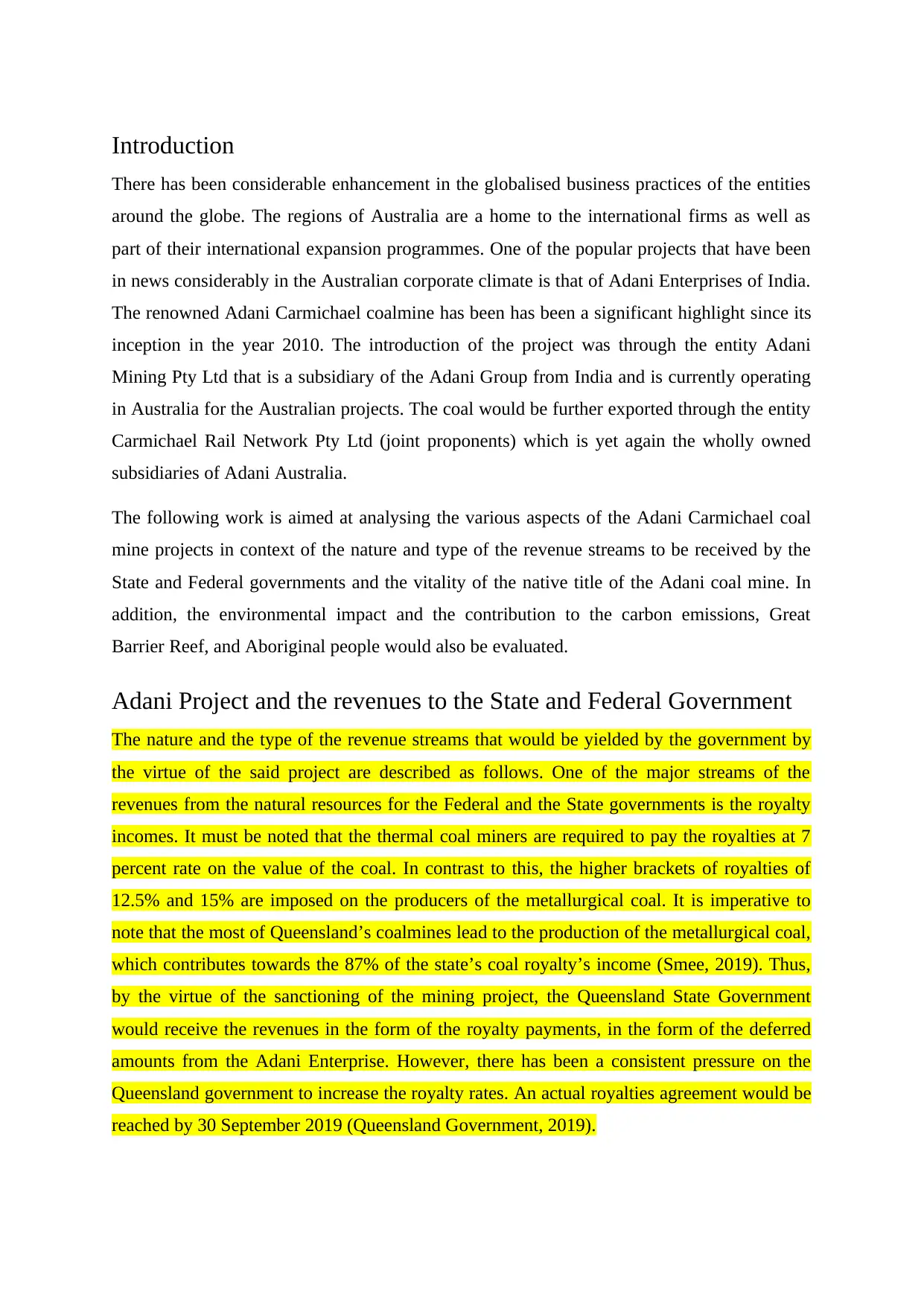
Introduction
There has been considerable enhancement in the globalised business practices of the entities
around the globe. The regions of Australia are a home to the international firms as well as
part of their international expansion programmes. One of the popular projects that have been
in news considerably in the Australian corporate climate is that of Adani Enterprises of India.
The renowned Adani Carmichael coalmine has been has been a significant highlight since its
inception in the year 2010. The introduction of the project was through the entity Adani
Mining Pty Ltd that is a subsidiary of the Adani Group from India and is currently operating
in Australia for the Australian projects. The coal would be further exported through the entity
Carmichael Rail Network Pty Ltd (joint proponents) which is yet again the wholly owned
subsidiaries of Adani Australia.
The following work is aimed at analysing the various aspects of the Adani Carmichael coal
mine projects in context of the nature and type of the revenue streams to be received by the
State and Federal governments and the vitality of the native title of the Adani coal mine. In
addition, the environmental impact and the contribution to the carbon emissions, Great
Barrier Reef, and Aboriginal people would also be evaluated.
Adani Project and the revenues to the State and Federal Government
The nature and the type of the revenue streams that would be yielded by the government by
the virtue of the said project are described as follows. One of the major streams of the
revenues from the natural resources for the Federal and the State governments is the royalty
incomes. It must be noted that the thermal coal miners are required to pay the royalties at 7
percent rate on the value of the coal. In contrast to this, the higher brackets of royalties of
12.5% and 15% are imposed on the producers of the metallurgical coal. It is imperative to
note that the most of Queensland’s coalmines lead to the production of the metallurgical coal,
which contributes towards the 87% of the state’s coal royalty’s income (Smee, 2019). Thus,
by the virtue of the sanctioning of the mining project, the Queensland State Government
would receive the revenues in the form of the royalty payments, in the form of the deferred
amounts from the Adani Enterprise. However, there has been a consistent pressure on the
Queensland government to increase the royalty rates. An actual royalties agreement would be
reached by 30 September 2019 (Queensland Government, 2019).
There has been considerable enhancement in the globalised business practices of the entities
around the globe. The regions of Australia are a home to the international firms as well as
part of their international expansion programmes. One of the popular projects that have been
in news considerably in the Australian corporate climate is that of Adani Enterprises of India.
The renowned Adani Carmichael coalmine has been has been a significant highlight since its
inception in the year 2010. The introduction of the project was through the entity Adani
Mining Pty Ltd that is a subsidiary of the Adani Group from India and is currently operating
in Australia for the Australian projects. The coal would be further exported through the entity
Carmichael Rail Network Pty Ltd (joint proponents) which is yet again the wholly owned
subsidiaries of Adani Australia.
The following work is aimed at analysing the various aspects of the Adani Carmichael coal
mine projects in context of the nature and type of the revenue streams to be received by the
State and Federal governments and the vitality of the native title of the Adani coal mine. In
addition, the environmental impact and the contribution to the carbon emissions, Great
Barrier Reef, and Aboriginal people would also be evaluated.
Adani Project and the revenues to the State and Federal Government
The nature and the type of the revenue streams that would be yielded by the government by
the virtue of the said project are described as follows. One of the major streams of the
revenues from the natural resources for the Federal and the State governments is the royalty
incomes. It must be noted that the thermal coal miners are required to pay the royalties at 7
percent rate on the value of the coal. In contrast to this, the higher brackets of royalties of
12.5% and 15% are imposed on the producers of the metallurgical coal. It is imperative to
note that the most of Queensland’s coalmines lead to the production of the metallurgical coal,
which contributes towards the 87% of the state’s coal royalty’s income (Smee, 2019). Thus,
by the virtue of the sanctioning of the mining project, the Queensland State Government
would receive the revenues in the form of the royalty payments, in the form of the deferred
amounts from the Adani Enterprise. However, there has been a consistent pressure on the
Queensland government to increase the royalty rates. An actual royalties agreement would be
reached by 30 September 2019 (Queensland Government, 2019).
Paraphrase This Document
Need a fresh take? Get an instant paraphrase of this document with our AI Paraphraser
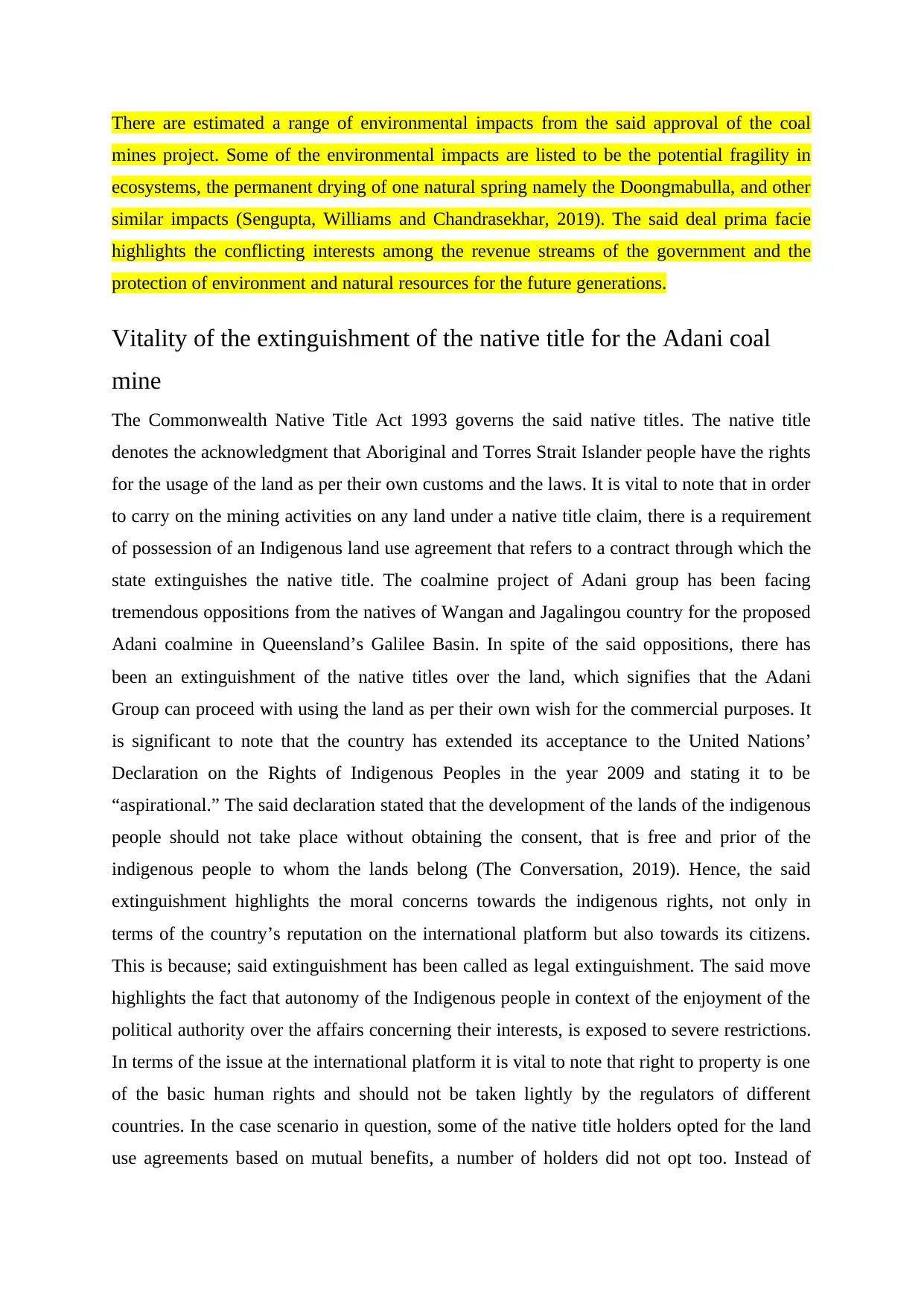
There are estimated a range of environmental impacts from the said approval of the coal
mines project. Some of the environmental impacts are listed to be the potential fragility in
ecosystems, the permanent drying of one natural spring namely the Doongmabulla, and other
similar impacts (Sengupta, Williams and Chandrasekhar, 2019). The said deal prima facie
highlights the conflicting interests among the revenue streams of the government and the
protection of environment and natural resources for the future generations.
Vitality of the extinguishment of the native title for the Adani coal
mine
The Commonwealth Native Title Act 1993 governs the said native titles. The native title
denotes the acknowledgment that Aboriginal and Torres Strait Islander people have the rights
for the usage of the land as per their own customs and the laws. It is vital to note that in order
to carry on the mining activities on any land under a native title claim, there is a requirement
of possession of an Indigenous land use agreement that refers to a contract through which the
state extinguishes the native title. The coalmine project of Adani group has been facing
tremendous oppositions from the natives of Wangan and Jagalingou country for the proposed
Adani coalmine in Queensland’s Galilee Basin. In spite of the said oppositions, there has
been an extinguishment of the native titles over the land, which signifies that the Adani
Group can proceed with using the land as per their own wish for the commercial purposes. It
is significant to note that the country has extended its acceptance to the United Nations’
Declaration on the Rights of Indigenous Peoples in the year 2009 and stating it to be
“aspirational.” The said declaration stated that the development of the lands of the indigenous
people should not take place without obtaining the consent, that is free and prior of the
indigenous people to whom the lands belong (The Conversation, 2019). Hence, the said
extinguishment highlights the moral concerns towards the indigenous rights, not only in
terms of the country’s reputation on the international platform but also towards its citizens.
This is because; said extinguishment has been called as legal extinguishment. The said move
highlights the fact that autonomy of the Indigenous people in context of the enjoyment of the
political authority over the affairs concerning their interests, is exposed to severe restrictions.
In terms of the issue at the international platform it is vital to note that right to property is one
of the basic human rights and should not be taken lightly by the regulators of different
countries. In the case scenario in question, some of the native title holders opted for the land
use agreements based on mutual benefits, a number of holders did not opt too. Instead of
mines project. Some of the environmental impacts are listed to be the potential fragility in
ecosystems, the permanent drying of one natural spring namely the Doongmabulla, and other
similar impacts (Sengupta, Williams and Chandrasekhar, 2019). The said deal prima facie
highlights the conflicting interests among the revenue streams of the government and the
protection of environment and natural resources for the future generations.
Vitality of the extinguishment of the native title for the Adani coal
mine
The Commonwealth Native Title Act 1993 governs the said native titles. The native title
denotes the acknowledgment that Aboriginal and Torres Strait Islander people have the rights
for the usage of the land as per their own customs and the laws. It is vital to note that in order
to carry on the mining activities on any land under a native title claim, there is a requirement
of possession of an Indigenous land use agreement that refers to a contract through which the
state extinguishes the native title. The coalmine project of Adani group has been facing
tremendous oppositions from the natives of Wangan and Jagalingou country for the proposed
Adani coalmine in Queensland’s Galilee Basin. In spite of the said oppositions, there has
been an extinguishment of the native titles over the land, which signifies that the Adani
Group can proceed with using the land as per their own wish for the commercial purposes. It
is significant to note that the country has extended its acceptance to the United Nations’
Declaration on the Rights of Indigenous Peoples in the year 2009 and stating it to be
“aspirational.” The said declaration stated that the development of the lands of the indigenous
people should not take place without obtaining the consent, that is free and prior of the
indigenous people to whom the lands belong (The Conversation, 2019). Hence, the said
extinguishment highlights the moral concerns towards the indigenous rights, not only in
terms of the country’s reputation on the international platform but also towards its citizens.
This is because; said extinguishment has been called as legal extinguishment. The said move
highlights the fact that autonomy of the Indigenous people in context of the enjoyment of the
political authority over the affairs concerning their interests, is exposed to severe restrictions.
In terms of the issue at the international platform it is vital to note that right to property is one
of the basic human rights and should not be taken lightly by the regulators of different
countries. In the case scenario in question, some of the native title holders opted for the land
use agreements based on mutual benefits, a number of holders did not opt too. Instead of
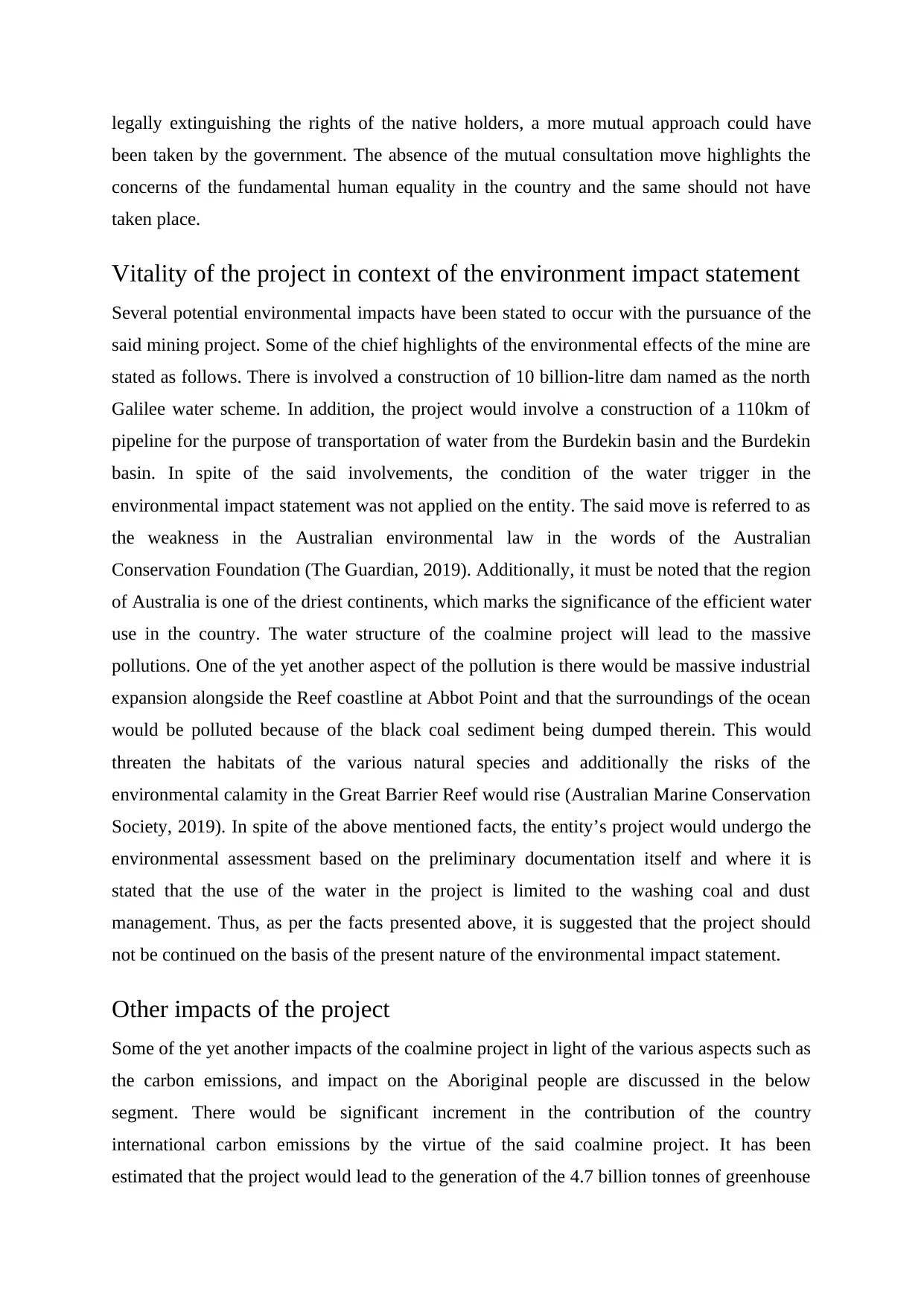
legally extinguishing the rights of the native holders, a more mutual approach could have
been taken by the government. The absence of the mutual consultation move highlights the
concerns of the fundamental human equality in the country and the same should not have
taken place.
Vitality of the project in context of the environment impact statement
Several potential environmental impacts have been stated to occur with the pursuance of the
said mining project. Some of the chief highlights of the environmental effects of the mine are
stated as follows. There is involved a construction of 10 billion-litre dam named as the north
Galilee water scheme. In addition, the project would involve a construction of a 110km of
pipeline for the purpose of transportation of water from the Burdekin basin and the Burdekin
basin. In spite of the said involvements, the condition of the water trigger in the
environmental impact statement was not applied on the entity. The said move is referred to as
the weakness in the Australian environmental law in the words of the Australian
Conservation Foundation (The Guardian, 2019). Additionally, it must be noted that the region
of Australia is one of the driest continents, which marks the significance of the efficient water
use in the country. The water structure of the coalmine project will lead to the massive
pollutions. One of the yet another aspect of the pollution is there would be massive industrial
expansion alongside the Reef coastline at Abbot Point and that the surroundings of the ocean
would be polluted because of the black coal sediment being dumped therein. This would
threaten the habitats of the various natural species and additionally the risks of the
environmental calamity in the Great Barrier Reef would rise (Australian Marine Conservation
Society, 2019). In spite of the above mentioned facts, the entity’s project would undergo the
environmental assessment based on the preliminary documentation itself and where it is
stated that the use of the water in the project is limited to the washing coal and dust
management. Thus, as per the facts presented above, it is suggested that the project should
not be continued on the basis of the present nature of the environmental impact statement.
Other impacts of the project
Some of the yet another impacts of the coalmine project in light of the various aspects such as
the carbon emissions, and impact on the Aboriginal people are discussed in the below
segment. There would be significant increment in the contribution of the country
international carbon emissions by the virtue of the said coalmine project. It has been
estimated that the project would lead to the generation of the 4.7 billion tonnes of greenhouse
been taken by the government. The absence of the mutual consultation move highlights the
concerns of the fundamental human equality in the country and the same should not have
taken place.
Vitality of the project in context of the environment impact statement
Several potential environmental impacts have been stated to occur with the pursuance of the
said mining project. Some of the chief highlights of the environmental effects of the mine are
stated as follows. There is involved a construction of 10 billion-litre dam named as the north
Galilee water scheme. In addition, the project would involve a construction of a 110km of
pipeline for the purpose of transportation of water from the Burdekin basin and the Burdekin
basin. In spite of the said involvements, the condition of the water trigger in the
environmental impact statement was not applied on the entity. The said move is referred to as
the weakness in the Australian environmental law in the words of the Australian
Conservation Foundation (The Guardian, 2019). Additionally, it must be noted that the region
of Australia is one of the driest continents, which marks the significance of the efficient water
use in the country. The water structure of the coalmine project will lead to the massive
pollutions. One of the yet another aspect of the pollution is there would be massive industrial
expansion alongside the Reef coastline at Abbot Point and that the surroundings of the ocean
would be polluted because of the black coal sediment being dumped therein. This would
threaten the habitats of the various natural species and additionally the risks of the
environmental calamity in the Great Barrier Reef would rise (Australian Marine Conservation
Society, 2019). In spite of the above mentioned facts, the entity’s project would undergo the
environmental assessment based on the preliminary documentation itself and where it is
stated that the use of the water in the project is limited to the washing coal and dust
management. Thus, as per the facts presented above, it is suggested that the project should
not be continued on the basis of the present nature of the environmental impact statement.
Other impacts of the project
Some of the yet another impacts of the coalmine project in light of the various aspects such as
the carbon emissions, and impact on the Aboriginal people are discussed in the below
segment. There would be significant increment in the contribution of the country
international carbon emissions by the virtue of the said coalmine project. It has been
estimated that the project would lead to the generation of the 4.7 billion tonnes of greenhouse
⊘ This is a preview!⊘
Do you want full access?
Subscribe today to unlock all pages.

Trusted by 1+ million students worldwide
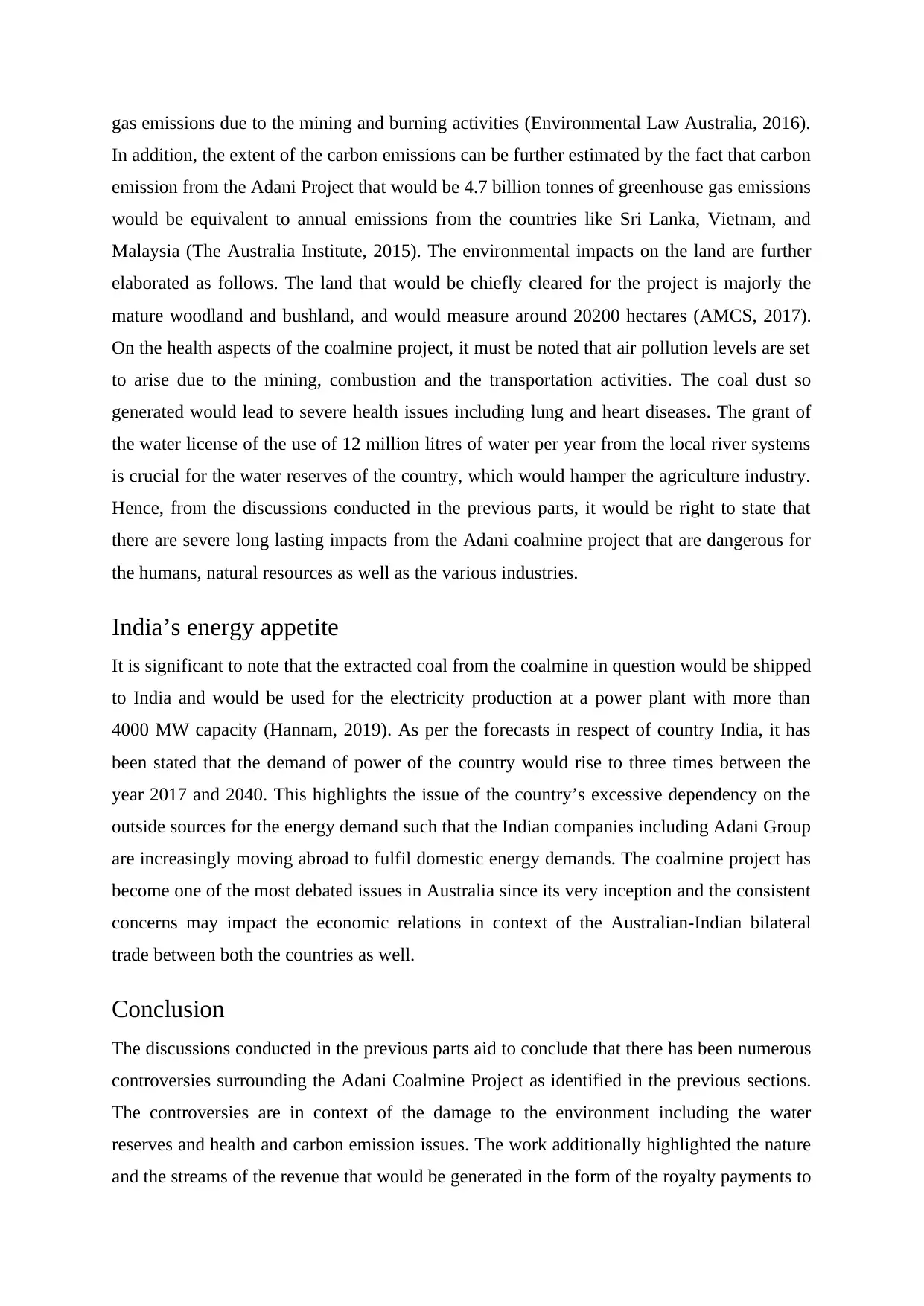
gas emissions due to the mining and burning activities (Environmental Law Australia, 2016).
In addition, the extent of the carbon emissions can be further estimated by the fact that carbon
emission from the Adani Project that would be 4.7 billion tonnes of greenhouse gas emissions
would be equivalent to annual emissions from the countries like Sri Lanka, Vietnam, and
Malaysia (The Australia Institute, 2015). The environmental impacts on the land are further
elaborated as follows. The land that would be chiefly cleared for the project is majorly the
mature woodland and bushland, and would measure around 20200 hectares (AMCS, 2017).
On the health aspects of the coalmine project, it must be noted that air pollution levels are set
to arise due to the mining, combustion and the transportation activities. The coal dust so
generated would lead to severe health issues including lung and heart diseases. The grant of
the water license of the use of 12 million litres of water per year from the local river systems
is crucial for the water reserves of the country, which would hamper the agriculture industry.
Hence, from the discussions conducted in the previous parts, it would be right to state that
there are severe long lasting impacts from the Adani coalmine project that are dangerous for
the humans, natural resources as well as the various industries.
India’s energy appetite
It is significant to note that the extracted coal from the coalmine in question would be shipped
to India and would be used for the electricity production at a power plant with more than
4000 MW capacity (Hannam, 2019). As per the forecasts in respect of country India, it has
been stated that the demand of power of the country would rise to three times between the
year 2017 and 2040. This highlights the issue of the country’s excessive dependency on the
outside sources for the energy demand such that the Indian companies including Adani Group
are increasingly moving abroad to fulfil domestic energy demands. The coalmine project has
become one of the most debated issues in Australia since its very inception and the consistent
concerns may impact the economic relations in context of the Australian-Indian bilateral
trade between both the countries as well.
Conclusion
The discussions conducted in the previous parts aid to conclude that there has been numerous
controversies surrounding the Adani Coalmine Project as identified in the previous sections.
The controversies are in context of the damage to the environment including the water
reserves and health and carbon emission issues. The work additionally highlighted the nature
and the streams of the revenue that would be generated in the form of the royalty payments to
In addition, the extent of the carbon emissions can be further estimated by the fact that carbon
emission from the Adani Project that would be 4.7 billion tonnes of greenhouse gas emissions
would be equivalent to annual emissions from the countries like Sri Lanka, Vietnam, and
Malaysia (The Australia Institute, 2015). The environmental impacts on the land are further
elaborated as follows. The land that would be chiefly cleared for the project is majorly the
mature woodland and bushland, and would measure around 20200 hectares (AMCS, 2017).
On the health aspects of the coalmine project, it must be noted that air pollution levels are set
to arise due to the mining, combustion and the transportation activities. The coal dust so
generated would lead to severe health issues including lung and heart diseases. The grant of
the water license of the use of 12 million litres of water per year from the local river systems
is crucial for the water reserves of the country, which would hamper the agriculture industry.
Hence, from the discussions conducted in the previous parts, it would be right to state that
there are severe long lasting impacts from the Adani coalmine project that are dangerous for
the humans, natural resources as well as the various industries.
India’s energy appetite
It is significant to note that the extracted coal from the coalmine in question would be shipped
to India and would be used for the electricity production at a power plant with more than
4000 MW capacity (Hannam, 2019). As per the forecasts in respect of country India, it has
been stated that the demand of power of the country would rise to three times between the
year 2017 and 2040. This highlights the issue of the country’s excessive dependency on the
outside sources for the energy demand such that the Indian companies including Adani Group
are increasingly moving abroad to fulfil domestic energy demands. The coalmine project has
become one of the most debated issues in Australia since its very inception and the consistent
concerns may impact the economic relations in context of the Australian-Indian bilateral
trade between both the countries as well.
Conclusion
The discussions conducted in the previous parts aid to conclude that there has been numerous
controversies surrounding the Adani Coalmine Project as identified in the previous sections.
The controversies are in context of the damage to the environment including the water
reserves and health and carbon emission issues. The work additionally highlighted the nature
and the streams of the revenue that would be generated in the form of the royalty payments to
Paraphrase This Document
Need a fresh take? Get an instant paraphrase of this document with our AI Paraphraser
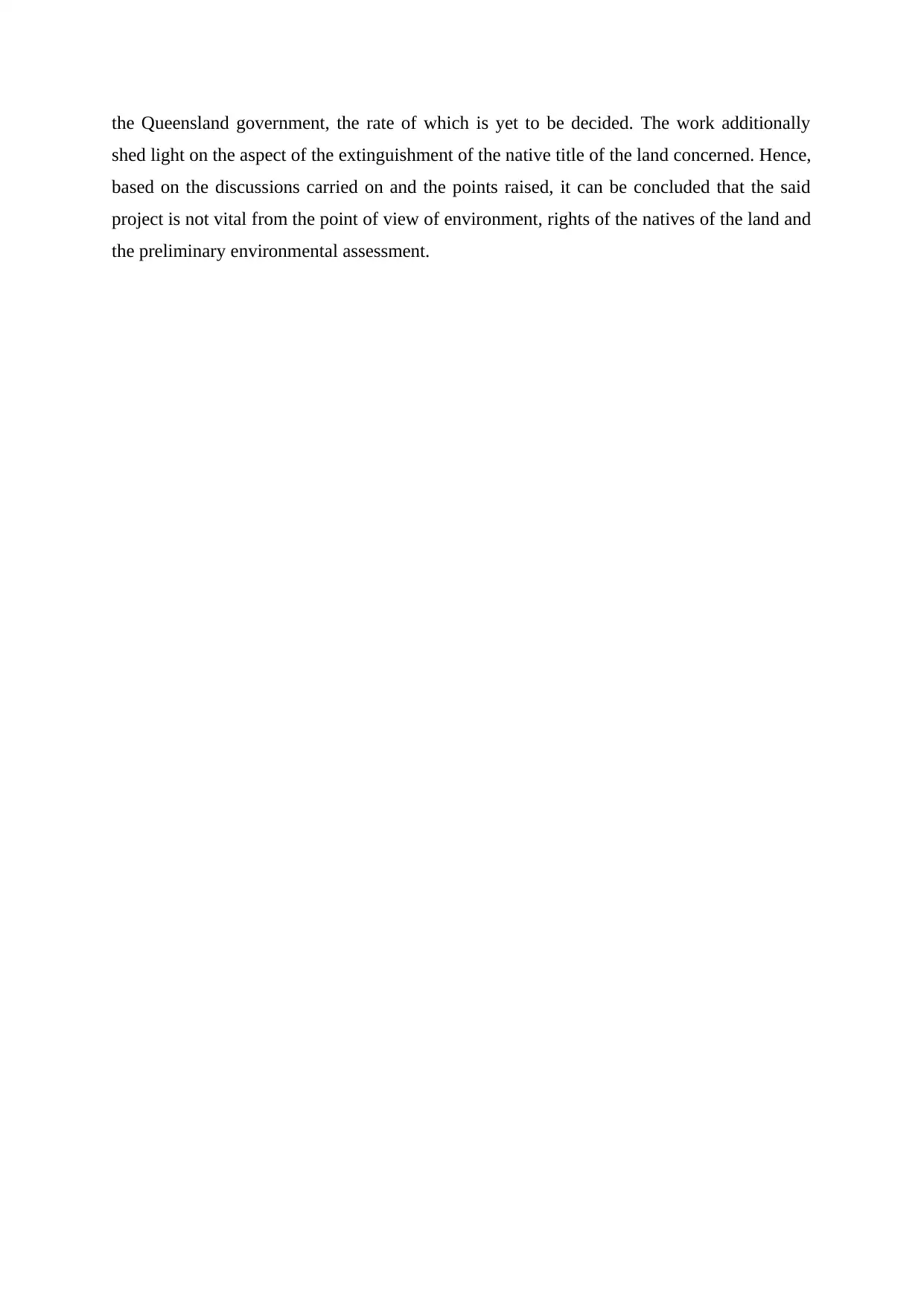
the Queensland government, the rate of which is yet to be decided. The work additionally
shed light on the aspect of the extinguishment of the native title of the land concerned. Hence,
based on the discussions carried on and the points raised, it can be concluded that the said
project is not vital from the point of view of environment, rights of the natives of the land and
the preliminary environmental assessment.
shed light on the aspect of the extinguishment of the native title of the land concerned. Hence,
based on the discussions carried on and the points raised, it can be concluded that the said
project is not vital from the point of view of environment, rights of the natives of the land and
the preliminary environmental assessment.
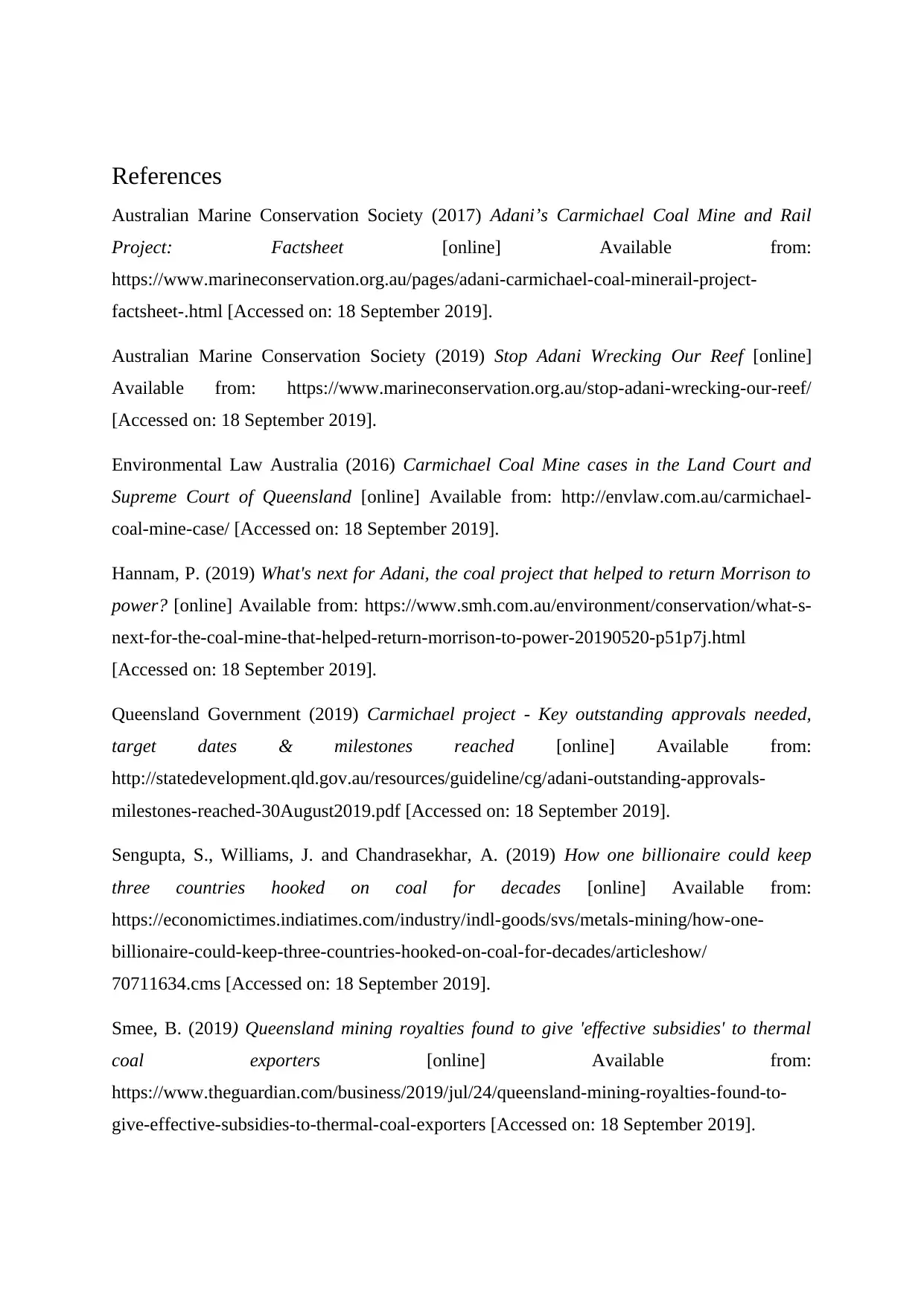
References
Australian Marine Conservation Society (2017) Adani’s Carmichael Coal Mine and Rail
Project: Factsheet [online] Available from:
https://www.marineconservation.org.au/pages/adani-carmichael-coal-minerail-project-
factsheet-.html [Accessed on: 18 September 2019].
Australian Marine Conservation Society (2019) Stop Adani Wrecking Our Reef [online]
Available from: https://www.marineconservation.org.au/stop-adani-wrecking-our-reef/
[Accessed on: 18 September 2019].
Environmental Law Australia (2016) Carmichael Coal Mine cases in the Land Court and
Supreme Court of Queensland [online] Available from: http://envlaw.com.au/carmichael-
coal-mine-case/ [Accessed on: 18 September 2019].
Hannam, P. (2019) What's next for Adani, the coal project that helped to return Morrison to
power? [online] Available from: https://www.smh.com.au/environment/conservation/what-s-
next-for-the-coal-mine-that-helped-return-morrison-to-power-20190520-p51p7j.html
[Accessed on: 18 September 2019].
Queensland Government (2019) Carmichael project - Key outstanding approvals needed,
target dates & milestones reached [online] Available from:
http://statedevelopment.qld.gov.au/resources/guideline/cg/adani-outstanding-approvals-
milestones-reached-30August2019.pdf [Accessed on: 18 September 2019].
Sengupta, S., Williams, J. and Chandrasekhar, A. (2019) How one billionaire could keep
three countries hooked on coal for decades [online] Available from:
https://economictimes.indiatimes.com/industry/indl-goods/svs/metals-mining/how-one-
billionaire-could-keep-three-countries-hooked-on-coal-for-decades/articleshow/
70711634.cms [Accessed on: 18 September 2019].
Smee, B. (2019) Queensland mining royalties found to give 'effective subsidies' to thermal
coal exporters [online] Available from:
https://www.theguardian.com/business/2019/jul/24/queensland-mining-royalties-found-to-
give-effective-subsidies-to-thermal-coal-exporters [Accessed on: 18 September 2019].
Australian Marine Conservation Society (2017) Adani’s Carmichael Coal Mine and Rail
Project: Factsheet [online] Available from:
https://www.marineconservation.org.au/pages/adani-carmichael-coal-minerail-project-
factsheet-.html [Accessed on: 18 September 2019].
Australian Marine Conservation Society (2019) Stop Adani Wrecking Our Reef [online]
Available from: https://www.marineconservation.org.au/stop-adani-wrecking-our-reef/
[Accessed on: 18 September 2019].
Environmental Law Australia (2016) Carmichael Coal Mine cases in the Land Court and
Supreme Court of Queensland [online] Available from: http://envlaw.com.au/carmichael-
coal-mine-case/ [Accessed on: 18 September 2019].
Hannam, P. (2019) What's next for Adani, the coal project that helped to return Morrison to
power? [online] Available from: https://www.smh.com.au/environment/conservation/what-s-
next-for-the-coal-mine-that-helped-return-morrison-to-power-20190520-p51p7j.html
[Accessed on: 18 September 2019].
Queensland Government (2019) Carmichael project - Key outstanding approvals needed,
target dates & milestones reached [online] Available from:
http://statedevelopment.qld.gov.au/resources/guideline/cg/adani-outstanding-approvals-
milestones-reached-30August2019.pdf [Accessed on: 18 September 2019].
Sengupta, S., Williams, J. and Chandrasekhar, A. (2019) How one billionaire could keep
three countries hooked on coal for decades [online] Available from:
https://economictimes.indiatimes.com/industry/indl-goods/svs/metals-mining/how-one-
billionaire-could-keep-three-countries-hooked-on-coal-for-decades/articleshow/
70711634.cms [Accessed on: 18 September 2019].
Smee, B. (2019) Queensland mining royalties found to give 'effective subsidies' to thermal
coal exporters [online] Available from:
https://www.theguardian.com/business/2019/jul/24/queensland-mining-royalties-found-to-
give-effective-subsidies-to-thermal-coal-exporters [Accessed on: 18 September 2019].
⊘ This is a preview!⊘
Do you want full access?
Subscribe today to unlock all pages.

Trusted by 1+ million students worldwide
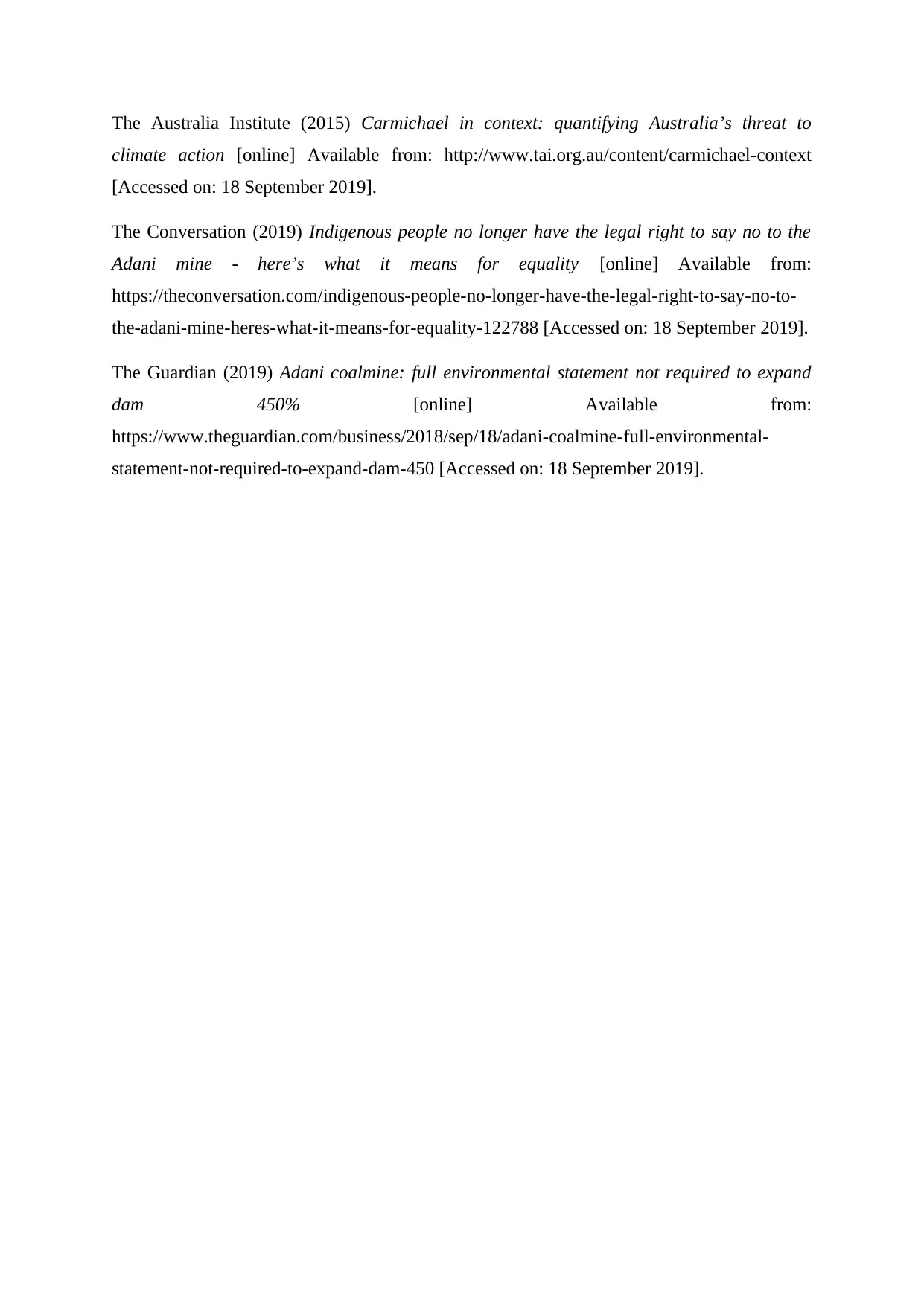
The Australia Institute (2015) Carmichael in context: quantifying Australia’s threat to
climate action [online] Available from: http://www.tai.org.au/content/carmichael-context
[Accessed on: 18 September 2019].
The Conversation (2019) Indigenous people no longer have the legal right to say no to the
Adani mine - here’s what it means for equality [online] Available from:
https://theconversation.com/indigenous-people-no-longer-have-the-legal-right-to-say-no-to-
the-adani-mine-heres-what-it-means-for-equality-122788 [Accessed on: 18 September 2019].
The Guardian (2019) Adani coalmine: full environmental statement not required to expand
dam 450% [online] Available from:
https://www.theguardian.com/business/2018/sep/18/adani-coalmine-full-environmental-
statement-not-required-to-expand-dam-450 [Accessed on: 18 September 2019].
climate action [online] Available from: http://www.tai.org.au/content/carmichael-context
[Accessed on: 18 September 2019].
The Conversation (2019) Indigenous people no longer have the legal right to say no to the
Adani mine - here’s what it means for equality [online] Available from:
https://theconversation.com/indigenous-people-no-longer-have-the-legal-right-to-say-no-to-
the-adani-mine-heres-what-it-means-for-equality-122788 [Accessed on: 18 September 2019].
The Guardian (2019) Adani coalmine: full environmental statement not required to expand
dam 450% [online] Available from:
https://www.theguardian.com/business/2018/sep/18/adani-coalmine-full-environmental-
statement-not-required-to-expand-dam-450 [Accessed on: 18 September 2019].
1 out of 7
Related Documents
Your All-in-One AI-Powered Toolkit for Academic Success.
+13062052269
info@desklib.com
Available 24*7 on WhatsApp / Email
![[object Object]](/_next/static/media/star-bottom.7253800d.svg)
Unlock your academic potential
Copyright © 2020–2025 A2Z Services. All Rights Reserved. Developed and managed by ZUCOL.




